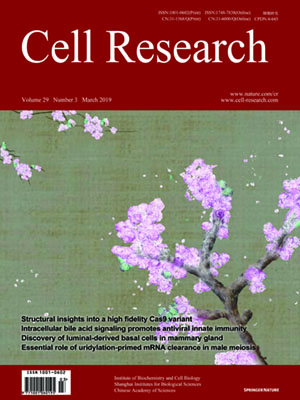Volume 29 Issue 3, March 2019: 248-250
LETTERS TO THE EDITOR
TET2 stabilization by 14-3-3 binding to the phosphorylated Serine 99 is deregulated by mutations in cancer
Hao Chen 1,2, Dingdang Yu 1, Rui Fang 3, Kimberlie Rabidou 3, Di Wu 3, Di Hu 3, Peilin Jia 4, Zhongming Zhao 4, Zhiping Wu 5, Junmin Peng5, Yang Shi 2 and Yujiang Geno Shi 1,3
1 Laboratory of Epigenetics, Liver Cancer Institute, Zhongshan Hospital, and Institutes of Biomedical Sciences, Fudan University, Shanghai 200032, China; 2 Division of Newborn Medicine and Program in Epigenetics, Children’s Hospital, Harvard Medical School, 300 Longwood Avenue, Boston, MA 02115, USA; 3 Endocrinology Division, Brigham and Women’s Hospital, Harvard Medical School,221 Longwood Avenue, Boston, MA 02115, USA; 4 Center for Precision Health, School of Biomedical Informatics, The University of Texas Health Science Center at Houston, Houston, TX 77030, USA and 5 Departments of Structural Biology and Developmental Neurobiology, St. Jude Children’s Research Hospital, Memphis, TN 38105, USA
Correspondence: Correspondence: Yujiang Geno Shi (yujiang_shi@hms.harvard.edu)
Dear Editor,
The Ten-Eleven Translocation-2 (TET2) gene encodes an enzyme
that catalyzes the conversion of 5-methylcytosine (5mC) to 5-
hydroxymethylcytosine (5hmC), the key initial step in active DNA
demethylation.1,2 TET2 and 5hmC function cooperatively as
epigenetic tumor suppressors and are frequently deregulated in
cancer.2 We recently reported that TET2 is a bona fide substrate of
the AMP-activated kinase (AMPK), which phosphorylates
TET2 serine 99 (S99) at its non-catalytic N-terminal region.3 Under
normal glucose conditions, this post-translational modification
stabilizes the TET2 protein. Importantly, we have demonstrated
that in hyperglycemic conditions, S99 phosphorylation is
impaired, thereby destabilizing TET2 and inactivating its tumor
suppressive function.3 These findings unveiled a “phospho-switch”
that serves to regulate TET2 stability and identified a cellular
pathway by which adverse extracellular signals, including high
glucose, act to disable the “phospho-switch,” resulting in
increased cancer risk. However, the underlying molecular mechanisms
through which the S99 phospho-switch protects
TET2 stability and how this regulatory mechanism is targeted by
cancer mutations are still unknown.
https://doi.org/10.1038/s41422-018-0132-5
FULL TEXT | PDF
Browse 1374


